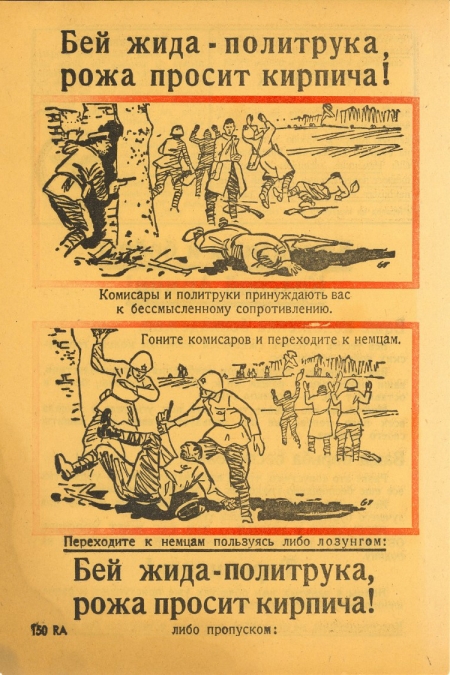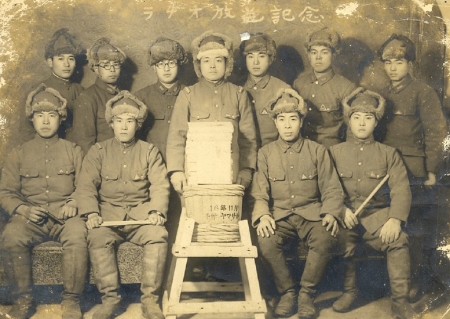
Overview
The Castañé Collection at Houghton Library gathers together documents, photographs, and books that tell the story of the pivotal political and military events of the 20th century.
Formed over a period of 25 years by José María Castañé, a Spanish businessman and patron of the arts, the collection focuses on:

- the Russian Revolution
- the Russian Civil War
- World War I
- the development of Fascism and Nazism
- the development of the Soviet Union
- the Spanish Civil War
- World War II, particularly the German invasion of the Soviet Union and major battles in the European theatre of war
- the Nuremberg Trials
- the Cold War
In size, the collection consists of some 3,000 individual items and small collections, numbering perhaps 15,000 pieces in all.
A small number of documents from the Castañé Collection were given by Mr. Castañé to the Residencia de Estudiantes, Madrid, Spain, in 2018.
The General Collection (MS Span 185)
Assembled document by document, the bulk of the textual material in the collection lies in this single series. It contains many iconic pieces, including:
- the hand-corrected text of President Truman’s announcement of the surrender of Germany on May 8, 1945 (JMC 6709)
- Winston Churchill’s appointment cards recording meetings during the Tehran and Yalta Conferences (JMC 6227 and 6228)
- documents by leaders including Adolf Hitler, Benito Mussolini, Francisco Franco, Vladimir Lenin, Leon Trotsky, Joseph Stalin, Charles de Gaulle, and many more
Documents by lesser-known figures provide a glimpse of personal perspectives. They include:
- the World War I diary of Sgt. George Williams, who fought at Verdun (JMC 5670)
- Albert Dupré’s letters from the French trenches (JMC 8381)
- a NKVD report of searches in February 1937 during the “Great Purge” (JMC 6696)
- an account of the summary execution of a Spanish Communist Party member (JMC 10077)
- a letter from an American soldier to his family about Russian prisoners of war in Dachau begging to be shot rather than returned to the U.S.S.R. and tried for treason (JMC 6181)
Single-Topic Document Collections
The Castañé Collection includes a number of smaller collections within it, including:
The Nuremberg Trial papers of U.S. judge Benjamin Kaplan (1911–2010)
American jurist Benjamin Kaplan was a lieutenant-colonel in the U.S. Army at the end of World War II. He was selected to help American prosecutors on the International Military Tribunal draft an indictment that would bring together elements of Anglo-American, Continental, and Soviet law.
The documents in this collection represent a selection of Kaplan's day-to-day working files at the time of the trial, such as: English translations of Nazi orders and legislation; U.S. army regulations regarding policies and procedures for the prosecution; and memoranda, reports, and legal arguments pertaining to the criminal charges aimed at the Nazi leadership.
Post-war letters by British Air Marshall Arthur “Bomber” Harris (1892–1984) about the carpet-bombing of German cities in World War II
This collection includes 72 letters exchanged between Royal Air Force Marshal Sir Arthur Harris and military historian Robert Wright about Harris’s role in the Allied air campaign in WWII.
Wright, a former Royal Air Force serviceman, was concerned with justifying Harris's controversial strategy of area bombing, in which civilians and non-military targets were included. This was a component of the policy of "total war" waged by Britain against Nazi Germany.
The archive of Prince SergeĬ Vladimirovich Gagarin (1868–1937)
Gagarin was Chief of the Chancellery of the Ministry of the Imperial Court under Tsar Nicholas II during one of Russia's most important periods.
In his role as chief secretary within the Tsar’s household, Gagarin was between the State Council and Duma, and the 142 documents he accumulated provide an impressively complete picture of legislative procedures.
The heart of the collection gives a snapshot of the activities of the Russian Provisional Government of February–October 1917. However, the archive spans the years 1906–1922, including some documents from early Russian émigré organizations and the acts of the Constitutional Assembly in exile in Paris, after the Bolsheviks took power.
Gagarin’s office continued to function after the Provisional Government took over, under the supervision of a commissar. Many of the documents are different versions of particular draft bills in the State Council and the State Duma, allowing one to trace changes, amendments, and comparisons, compiled by the State Chancellery, of wording from the different versions of the bill.
Topics covered include a variety of political, educational, and economic issues: rules and provisions for electing a Constituent Assembly; the regulation of unions and other voluntary associations; production of fertilizers in 1915–16; legislation administration of aid to wounded soldiers, war widows, and orphans; and the functioning and membership of the State Duma and the State Council.
Perhaps the most important documents are reports of meetings in the crucial months of February and March 1917, and the first meetings of the Council and the Duma after the Tsar resigned.
The collection as a whole represents the history of Russia in one of its most important periods.
Visual Materials
The visual materials in the Castañé Collection are particularly rich for historical research.
Some photographs are included in the general collection series, generally by unknown photographers. For example: Nadezhda Krupskaia giving a speech promoting literacy in Moscow, 1927 (JMC 1913); Japanese soldiers in winter uniform, November 1941 (JMC 1577); and a group of eight photographs of the concentration camp at Nordhausen (JMC 8391).

Photograph albums compiled by unknown officers and soldiers provide a personal perspective on war. They share common themes, including: landscapes, the civilian population, prisoners of war, soldier everyday life, military equipment, destruction, and graves.
These anonymous unpublished photographs are supplemented by photographs by well-known Soviet photographers, including many iconic images from World War II; photos by official Nazi Party photographer Heinrich Hoffman; and photos by Izvestia photographer Sergei Smirnov.
Some highlights in the collection include:
- 70 photograph albums compiled by officers and soldiers containing approximately 10,000 separate prints. Many are German albums from World War II showing the Blitzkrieg in Poland, France and the Low Countries, and Operation Barbarossa. Other events documented in these albums include World War I (JMC 2240, 2341), the Spanish Civil War (JMC 4484 and others), Vietnam (JMC 2489), and the Soviet army in East Germany (JMC 2494). This series also includes British and U.S. albums about campaigns in North Africa, the Pacific, and the Baltic.
- Iconic documentary photos of World War II in the Soviet Union by Soviet photojournalists
- Documentary photos from the Spanish Civil War by Barcelona photojournalist Agustí Centelles
- A set of unpublished original negatives from official Nazi Party photographer Heinrich Hoffmann, including images of the Nuremberg Party Day celebrations in 1934 and 1935
- Original photographs of the political lives of Nikita Khrushchev and Leonid Brezhnev, many unpublished, taken by Sergei Smirnov, chief photographer at the Moscow newspaper Izvestia
- Portrait photographs, autographed, of political and cultural leaders
- Portrait photographs, autographed, of military leaders
Printed Materials
Printed materials in the collection range in date from 1900s to the 1980s. Many are signed by their authors, or bear important inscriptions.
Covering the same topics as the documents, highlights include:

- a rare proof copy of the Treaty of Versailles, the personal copy of Irving Hoover, an aide to President Woodrow Wilson who accompanied Wilson to Versailles for the signing of the treaty
- Stalin’s book on Lenin, inscribed by Stalin to Tatiana Slavotinskaia (rumored to have been his lover)
- Kim Philby’s marked copy of George Unwin’s Studies in Economic History
- an illustrated children’s biography of Adolf Hitler
- the Hawaii Office of Civil Defense pamphlet on air raid precautions, issued shortly after the attack on Pearl Harbor
- Field-Marshal Montgomery’s own copy of his Normandy to the Baltic, published for private circulation to the British army of the Rhine
- key Nazi texts such as Hitler’s Mein Kampf and Alfred Rosenberg’s Der Mythus des 20. Jahrhunderts
- presentation copies of books by Leonid Brezhnev
Additionally, there are three small collections of printed material:
- Russian revolutionary posters and flyers
- German propaganda flyers, in Russian, dropped over Byelorussia, Russia and Ukraine during World War II
- Chromolithographic portraits of Spanish Civil War nationalist military leaders edited by official photographer Jalón Ángel, stamped as private property of General Francisco Franco
Accessing These Materials
Material in the Castañé Collection can be found in in HOLLIS by a keyword search for José María Castañé Collection.
An illustrated essay by the donor and collector, “The José María Castañé Collection of Twentieth-Century Historical Documents: Its Origins and Development,” is published in Harvard Library Bulletin, Volume 25, Number 3 (July 2015). Contact Houghton Library to request copies.